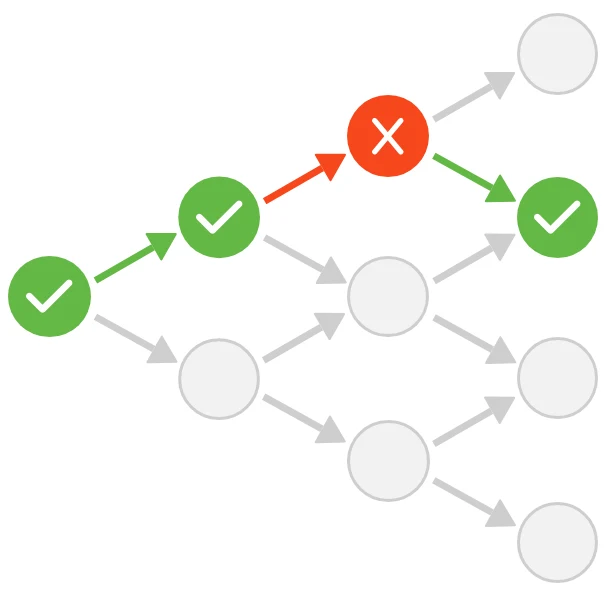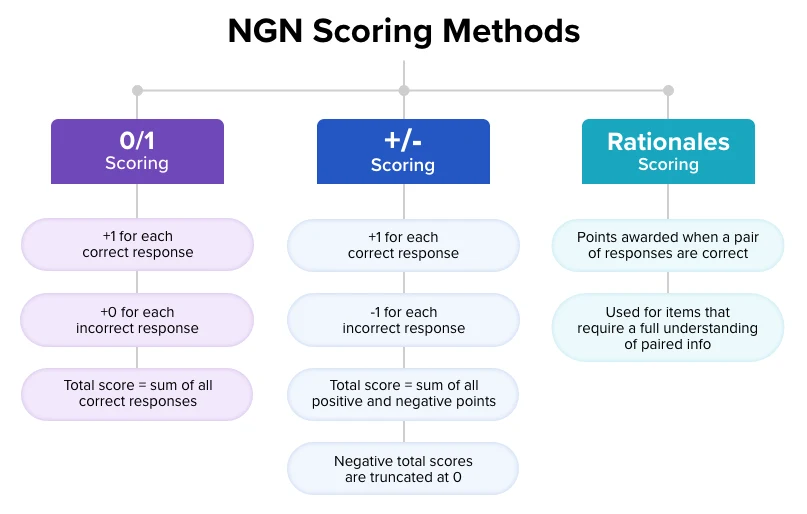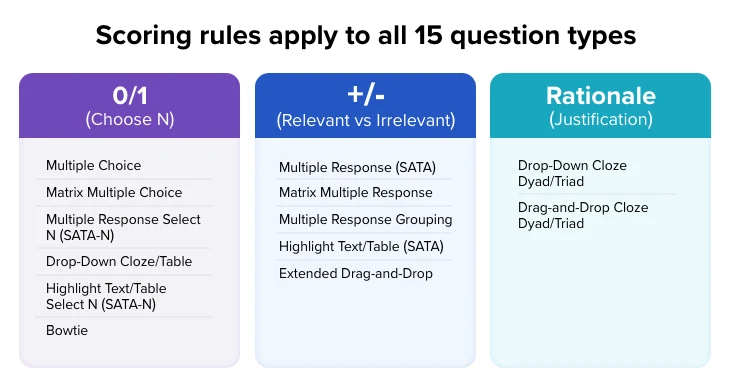National Council Licensure Examination for Registered Nurses (NCLEX-RN®) and National Council Licensure Examination for Practical Nurses (NCLEX-PN®) passing rates are released by the National Council of State Boards of Nursing (NCSBN) every year. Understanding what constitutes a “pass” and how the NCLEX is scored can be confusing, especially with the introduction of the Next Generation NCLEX’s (NGN’s) scoring model.
This guide provides everything you need to know about NCLEX scoring, including pass rates for 2025, current passing standards, and scoring methods.
2025 Pass Rates for NCLEX-RN and NCLEX-PN
The charts below indicate NCLEX exam pass rates for first-time and repeat test-takers in the United States and internationally.
2025 NCLEX-RN Pass Rates
2025 NCLEX-PN Pass Rates
| 2025 NCLEX-RN Pass Rates | ||||
|---|---|---|---|---|
| Candidates | January-March | April-June | July-September | YTD Total |
| First-time, U.S. educated | 88.4% | 89.1% | 83.6% | 87.5% |
| Repeat, U.S. educated | 51.4% | 47.5% | 58.7% | 52.6% |
| First-time, international | 46.5% | 46.3% | 47.7% | 46.7% |
| Repeat, international | 30.1% | 29.8% | 31.1% | 30.2% |
| Total | 71.6% | 73.7% | 69.5% | 71.9% |
| 2025 NCLEX-PN Pass Rates | ||||
|---|---|---|---|---|
| Candidates | January-March | April-June | July-September | YTD Total |
| First-time, U.S. educated | 86.3% | 86.5% | 89.4% | 87.4% |
| Repeat, U.S. educated | 38.2% | 42.3% | 43.7% | 41.2% |
| First-time, international | 61.3% | 45.3% | 50.7% | 54.0% |
| Repeat, international | 36.5% | 18.5% | 30.1% | 27.3% |
| Total | 77.3% | 75.6% | 82.2% | 78.3% |
For more information about NCLEX pass rates, please visit NCSBN.org.
You’ll notice that pass rates among repeat test-takers are markedly lower than those of first-time test-takers. This is likely due to students following a poor study plan or using low-quality resources, then retaking the exam without making changes.
How Is the NCLEX Scored?
The NCLEX uses Computerized Adaptive Testing (CAT) to deliver questions tailored to your unique ability, more accurately measuring your competence. CAT uses an algorithm to display questions with varying difficulty based on your response to the previous question. Initially, you’ll receive a question with a difficulty level near the passing score.
If you respond correctly, the next question will be a little more difficult, or vice versa. The CAT algorithm is designed to present questions for which you have a 50% chance of answering correctly. This process continues until 1 of 3 pass/fail rules is met.
What Are the NCLEX Pass/Fail Rules?
The CAT algorithm determines whether you pass or fail based on 1 of the following 3 rules. These rules are sometimes called the exam’s “stopping rules” that indicate when the exam will end.
- 95% Confidence Interval: The exam ends when the computer is 95% certain that your ability is above (pass) or below (fail) the passing standard.
- Maximum-Length Exam: If you receive the maximum number of questions and your ability is close to the passing standard, the computer will determine whether you receive a pass or fail score.
- Run-Out-of-Time (ROOT): If time runs out and you have not answered the minimum number of questions, you will fail. If you have answered the minimum number of questions, the computer will determine a pass or fail based on existing responses.
What Is the NCLEX Passing Score Standard?
Every 3 years, the National Council of State Boards of Nursing (NCSBN) reviews the NCLEX-RN and NCLEX-PN passing standards. NCSBN convenes nurse expert panels and analyzes practice-analysis data to inform recommendations. The Board of Directors then votes to set the passing standard.
The NCLEX test plans outline the knowledge, skills, abilities, and clinical judgment expected of entry-level nurses. As of 2024, the passing standards are 0.00 logits (RN) and –0.18 logits (PN), in effect through March 31, 2026.
Next Gen NCLEX (NGN) Question Scoring Models
The NGN includes new question types that better measure clinical judgment required by entry-level nurses in clinical practice. Along with the new question types, NCSBN has also adopted more nuanced scoring models.
What Is Polytomous Scoring?
Polytomous scoring awards partial credit for correct responses on questions with more than 1 correct answer. Each answer option is assigned a point value. You are awarded 1 point for each correct response you select. So, for a question with 3 possible correct responses, if you select 2 of the 3 possible, you will be awarded 2 points instead of no points as with traditional, dichotomous scoring.
How Are NGN Questions Scored?
NGN questions use 3 scoring methods: 0/1, +/-, and rationales:
- 0/1 (dichotomous): Earn 1 point for a correct answer and 0 points for an incorrect answer; no partial credit.
- +/− (partial credit with penalties): Points are added for correct selections and subtracted for incorrect selections; avoid selecting options you’re not confident about.
- Rationale (dependent pair): Credit is awarded only when both the action (X) and the reason (Y) are correct because they depend on each other.
Which Scoring Rule Applies to Each NGN Question Type?
Each of the 15 question types is scored with 1 of the 3 scoring methods. For example, multiple-choice questions are scored with 0/1, multiple-response questions with +/-, and questions that require paired information with rationales scoring. The table below organizes question types by how they are scored:
When Can You See Your NCLEX Score?
Nursing Regulatory Bodies (NRBs) take about 6 weeks from an exam date to send NCLEX results. Although the computer scores your exam in real time, results are not released at the test center, and staff cannot access them. Instead, your exam record is transmitted to Pearson VUE, where it’s graded a second time. If you haven’t received your results within 6 weeks, contact your NRB. Do not contact Pearson VUE or the test center.
How to Know if You Passed the NCLEX Right Away
You can’t. There’s no instant pass/fail at the test center. The fastest hint is Pearson VUE Quick Results (~2 business days, paid, unofficial). Your nursing regulatory body issues the only official result, which can take longer. Contrary to what you might read online, there is no “Pearson VUE hack” to get your results faster.
Frequently Asked Questions (FAQs)
What happens if I fail the NCLEX 3 times?
If you fail the NCLEX 3 times, most Nursing Regulatory Bodies (NRB) require you to complete a board-approved remediation program before retesting. This policy varies by state, so contacting your NRB to understand your specific requirements and next steps is essential.
What score do you need to pass the NCLEX?
There isn’t a percentage “score.” You pass when the CAT estimates your ability above the passing standard with 95% confidence. The current standards are 0.00 logits (RN) and –0.18 logits (PN).
Read More About the NCLEX
You can’t pass an exam you don’t take. Understanding eligibility requirements and how to register for the NCLEX is your first step toward passing. Check out this guide for details.
There’s a lot more to the NCLEX than how it’s scored. Read this guide for critical information on the exam’s organization, 8 content areas, question types, and more.
Studying for an exam is half the battle. The other is knowing exactly what to study and how to study it. Check out this comprehensive blueprint for the NCLEX.
We’ll walk you through the NCLEX-RN test plan. Learn everything you need to know about client need categories, including their weightage and subtopics.
Dive deep into the NCLEX-PN test plan. This guide elaborates on exactly what you need to study for each content area and its relative importance.








